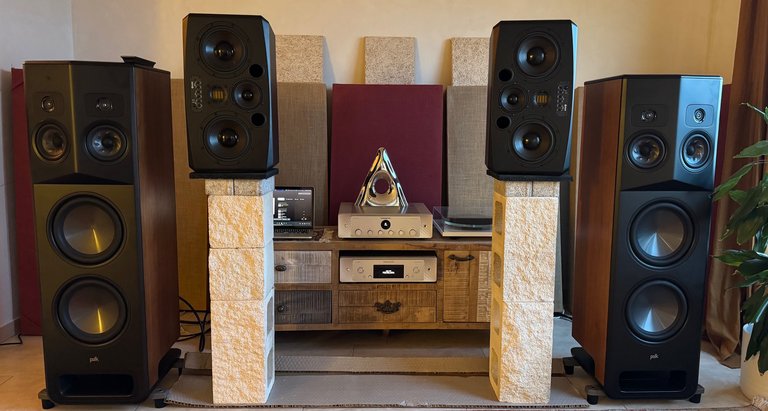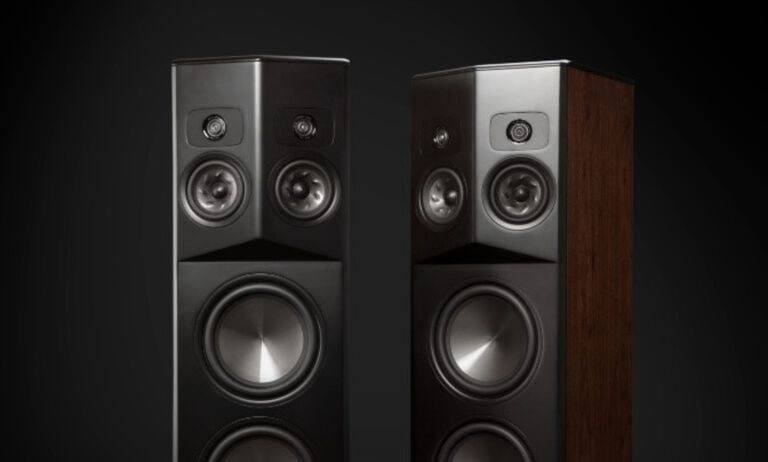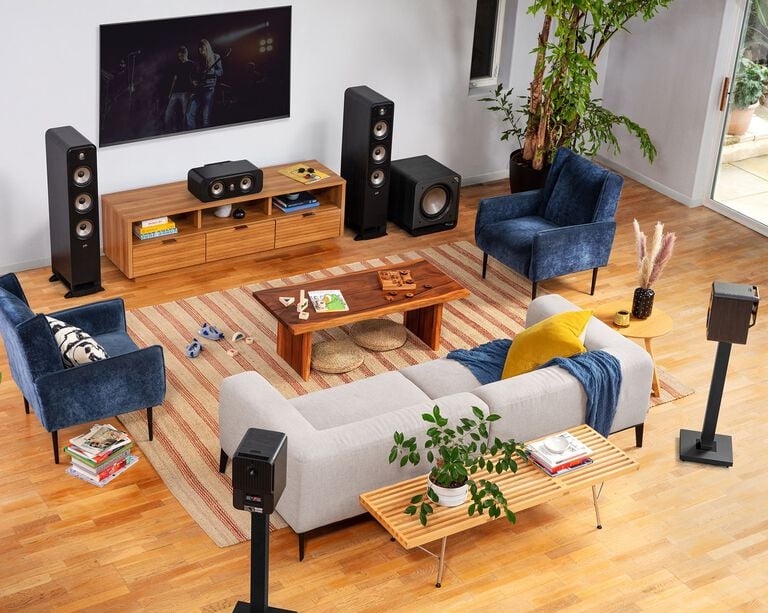How hi-fi changed the way Snarky Puppy mixes records
Article written by SARAH JONES

Snarky Puppy knows how to build a mix that music lovers obsess over. For its new orchestral project SOMNI, recorded in collaboration with the Metropole Orkest, the Grammy-winning jazz-fusion collective brought Polk Audio’s Legend L800 speakers into the studio as a critical reference. It’s an unconventional move—using hi-fi towers in a pro studio environment—but for bandleader Michael League and mix engineer Nic Hard, the speakers’ clarity and highly accurate soundstage made them a creative asset, not just a playback tool.
The L800s feature Polk’s patented SDA (Stereo Dimensional Array) technology, which eliminates interaural crosstalk, the signal that tells your brain where the speakers are, versus the actual sonic images of the instruments. With that distortion removed, you hear a more precise, open soundstage where instruments and voices feel like they’re placed naturally in space—so the speakers disappear and the performance comes alive.
League and Hard have long relied on Polk speakers to check mixes in home environments, but SOMNI marks the first time those same speakers played a central role in shaping the final sound of a record. We spoke with them about mixing for music lovers, chasing feel over perfection—and why “enjoyable” might be the most underrated quality in a studio tool.

Bring us up to speed on your newest project. You’ve been in Spain recording a new album?
League: We just finished the new Snarky Puppy record, which is called SOMNI. It’s a beast of a record with 74 musicians on it—it’s a collaboration with the Metropole Orchestra, conducted by Jules Buckley. That’s coming out November 21; it’s going to be a Blu-ray and film and album. We did that at Nic’s house with Polk speakers.
How do you collaborate in the studio, and how does technology serve that process?
League: Nic and I, if you lowball it, I think we’ve worked on 50 or 60 records together. And if you count all of the live albums, we’ve done several hundred.
I would say that of all of the elements of the post-production process, the music and the relationship between producer and engineer are the biggest factors. In Nic and my case it’s a pretty well-oiled machine at this point, and the technology is an enhancer.
The technology in the studio is exactly like an instrument to a musician. If you put any instrument in the hands of a capable musician, they’re going to sound like themself and they’re going to create something that sounds good. But the difference between a bad instrument and a great instrument is going to be the difference between them sounding really good and sounding amazing.
Nic and I very much value having great speakers, having great software, all that technology. For me, it’s the difference between something being an 8.5 and something being a 10.
I think of Snarky Puppy as being musicians’ musicians; your music tends to invite deeper engagement than a lot of, say, pop. How does your fan base come into play as you’re mixing for the end listening scenario?
Hard: Snarky definitely has a large number of fans that appreciate hi-fi audio with a lot of people buying vinyl. There have definitely been fans who have reached out to me to talk about the sonic stuff and I thought it was important for this album to appeal to that crowd.

Michael, your journey with Polk started way back with a pair of classic LsiM 705s, towers that predated the Legend series.
League: We’ve used those 705s as fun monitors in my living room, where when we’re done working, after we have dinner, we go down and listen on those. I don’t know how many records we’ve done on those, Nic—ten? 15?
Hard: Possibly more. They’ve been a consistent reference for us. Those and, of course, the obligatory car test as well.
League: I think the first record we did with them was my solo record [So Many Me], which would have been 2021. So for the past four years, every record we’ve done, we’ve used the LsiM 705s as our home test.
And then Nic, later on you ended up with Legend L800s in your home studio in Spain. When did you bring them into the mixing process?
Hard: It sort of happened by accident. It was just a desire to listen to that (SOMNI) recording in a slightly different context than other records. They had been set up in my living room, used mostly for listening to masters and other people’s records, not for mixing. I had the idea that I wanted to hear it in its most beautiful way, rather than the most common way and the Polks (L800) seemed like a good fit.
When I started mixing, I ended up mixing on them most of the time, which is counter to what I would usually do…because they sound too good.
I was also tailoring this record more to the audiophile world and caring more about what that audience are going to listen on rather than the people who will listen on their earbuds and laptops…Because that’s normally the consideration. I thought for this project, because it’s such a big record and it’s orchestral, it might be nice to do it the other way around and focus on the really pretty-sounding speakers.
What was your intention when you first got the L800s? Were you ever planning to use them during mixing?
Hard: The intention was just a nice listening environment. I heard them and I thought they were incredible sounding. We talked about getting a pair here, basically just for me to have an alternate listening environment, like we do at Mike’s.
The intention was not to listen on them all day long, but to use them to check things at the end. And for a while, when people would send masters, I would listen to the masters back on those because they were the nicest-sounding speakers that I had.
It’s interesting because we tend to think of studio monitors as less forgiving and more revealing of certain characteristics.
Hard: That is the philosophy behind studio monitors. But the fact is that they’re not as good as the L800s.
I think it’s actually the opposite with the L800s—you can hear more, there’s more clarity in it. In that way, it’s kind of intimidating, because when you have all of these little details and things that need to be cleaned up, it’s actually more work.
For this record in particular, I thought it was pertinent to use them. And especially having somebody like Jules Buckley, who’s has a ridiculous set of ears, listening as well, I wanted him to be really comfortable and have the best listening experience possible.

Were there moments where listening on the Polks helped shape a creative process in the studio?
Hard: Certainly on this record, especially because I started more or less mixing on them. You know, I had them and my studio monitors set up, but for a lot of the process I just stayed on the L800s because they’re so enjoyable to listen to. It made the decision making easy.
When it comes to being creative, if you’re enjoying what you’re listening to, it comes a lot easier.
I love the word enjoyable, because people rarely describe studio monitors as being enjoyable. Michael, how does that apply to you as an artist?
League: Every tool that you’re using at any moment in the studio is affecting the creative process.
On my solo record, every night at the end of mixing, we’d go and sit down in my living room and listen to what we had done on the Polks. And I remember we made a lot of decisions about low end, for example, because upstairs you didn’t hear it as much downstairs. It was overpowering.
The acoustics of the room, how much sleep you’ve gotten, have you had a drink, all these things affect the listening process.
But Nic has influenced me a lot in the way of like not keeping the production process in a glass case, understanding that people will have a cocktail before they listen to your record; people will listen to it incredibly loud, even though it’s more accurate when you listen to it soft; and people will listen to it in rooms that aren’t perfectly designed for listening to music.
And so rather than chasing this dragon of the perfect mix, it’s more about creating a listening experience that’s enjoyable in a lot of different settings, even if the way in which it’s enjoyable changes. When you’re a mix engineer, inherently you’re going to work hard to make something perfect. But the thing that makes it perfect is the set of circumstances within which you’re mixing.
As soon as you take the music out of those circumstances and put it on different speakers in a different room with a different set of ears, it stops being perfect. It’s actually very Zen in a way.
That’s an interesting way to kind of close that circle with the listener—having that experience yourself as part of the process of finishing a record.
Yeah, for sure.
Are there particular details you hear on Polks that you miss on other systems? And has that shaped mix decisions?
Hard: Oh, a thousand percent. Especially when checking masters. I might hear a top-end hiss or some rumble or something and then actually go and revise the mix and send it back to mastering. There have been lots of times where I’ve gone back and revised things because the Polks highlighted elements that I hadn’t noticed before.
The Polks reveal so much more clarity and detail than the studio monitors that working with them all the time can be a bit overwhelming—there’s just so much happening. They really show you everything—the blemishes and all.
The L800s feature Polk’s SDA, or stereo dimensional array technology, which eliminates interaural crosstalk. In simple terms, SDA allows each ear to hear only its respective channel, revealing the true stereo imaging in your mix with pinpoint accuracy. I understand you were working with 240 tracks—how did listening in SDA help you evaluate the soundstage?
Hard: I think what the SDA is doing is contributing to that clarity and things feel more precisely placed in the mix, because of the wider image. It’s like there’s actually more space for the elements to occupy so that I can hear the detail of the placement more accurately.
In the end, do you think that using Polk speakers to evaluate your mixes helped you produce a better product?
Hard: it definitely made the process more enjoyable for us.
League: Musicians always play better when they’re happy. When you’re feeling good and you’re having a good time, you generally do things better.
Nic just built a new studio at his house to make the process of what he does nicer. I moved to Spain and built a studio in my house to make the process nicer. And so I do think that people do better work when they’re enjoying themselves.
That enjoyment can come from the quality of the speakers they’re using. It can come from the quality of the food they’re eating. It can definitely come from the quality of the company that they have around them while they’re working. That can come from a lot of different places. But I believe very strongly that if you’re enjoying yourself, you do better work for sure.
SOMNI will be released on November 21 via GroundUP Music; pre-save the album here


